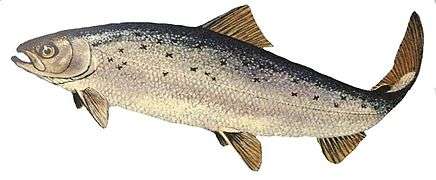Oncorhynchus rastrosus
| Oncorhynchus rastrostus Temporal range: Late Miocene to Pleistocene | |
|---|---|
| | |
| Scientific classification | |
| Kingdom: | Animalia |
| Phylum: | Chordata |
| Class: | Actinopterygii |
| Order: | Salmoniformes |
| Family: | Salmonidae |
| Genus: | Oncorhynchus |
| Species: | †O. rastrosus |
| Binomial name | |
| †Oncorhynchus rastrosus (Cavender & Miller, 1972) | |
| Synonyms | |
|
Smilodonichthys rastrosus | |
Oncorhynchus rastrosus (synonym Smilodonichthys rastrosus[1]) also known as the sabertooth salmon,[2] is an extinct species of salmon that lived along the Pacific coast of North America, first appearing in the late Miocene of California, then dying out some time during the Pleistocene. Adults grew to be 2.7 m (9 ft) in length and are believed to have been anadromous like their living relatives. Besides being the largest member of the Pacific salmon genus Oncorhynchus, members of this species had a pair of small "fangs" protruding from the tip of the snout, thus explaining the common name and synonym. Beyond their fangs, adults of O. rastrosus had larger gill rakers compared to their smaller, modern relatives, leading scientists to suggest that the adults ate plankton.[3]
References
- ↑ Cavender, T., & Miller, R. R. (1972). Smilodonichthys rastrosus: A new Pliocene salmonid fish from Western United States. Museum of Natural History, University of Oregon.
- ↑ "Saber-toothed Salmon", The Museum of Natural and Cultural History, University of Oregon
- ↑ Thomas P. Eiting, Gerald R. Smith, Miocene salmon (Oncorhynchus) from Western North America: Gill Raker evolution correlated with plankton productivity in the Eastern Pacific, Palaeogeography, Palaeoclimatology, Palaeoecology, Volume 249, Issues 3–4, 19 June 2007, Pages 412-424, ISSN 0031-0182
